Too many children struggle to learn to read — too many fail. In the age of digital devices, it seems likely this will increase. And it is completely unnecessary!
Parents, grandparents and other caregivers can easily ensure their child’s success. This page tells you how.
It explains how and why your help is so important and starts you off with a simple activity you can weave into your regular routine — while grocery shopping.
With this activity, you can prepare a preschooler for success or help an older child who’s struggling in school.
Click here for PRINTABLE PDF VERSION OF THIS ENTIRE ACTIVITY: “Reading is Child’s Play.”
But first, How does a small child learn — naturally?
To carry out this activity effectively with your child, it’s important to see how and why it works, and this takes recognizing how a child learns — naturally. So let’s first look at the skill-building strategies nature has given a child.
Consider walking. The infant doesn’t go directly from sitting up to walking. They first creep, crawl, stand, take a few steps while holding on — then one day they walk. So their progress is a series of stages, each more complex.
Also, you didn’t “teach” the infant to walk, but you did provide the environment for it.
Think of learning to read as unfolding in stages, too, with you providing a print-rich environment.
Now recall how they learned to speak. You didn’t sit your child in their high chair and demonstrate how to say a word your had decided upon that day.
You didn’t tell them the meaning of the word, then describe how to place their tongue just so and use their breath in certain ways to make the sounds needed.
 No, as you carried out some activity with special meaning for your child, you modeled the words associated with it. For instance, as you handed them their cup of milk and saw them smiling with delight, you said something like, “You love your milk!” or, “Milk is very good!” Then before long, as soon as they saw you pouring their milk, they began excitedly calling out, “Milk, milk milk!”
No, as you carried out some activity with special meaning for your child, you modeled the words associated with it. For instance, as you handed them their cup of milk and saw them smiling with delight, you said something like, “You love your milk!” or, “Milk is very good!” Then before long, as soon as they saw you pouring their milk, they began excitedly calling out, “Milk, milk milk!”
So the child spontaneously absorbs information, and in ways we cannot fully see, they develop the skills needed to copy what someone models for them.
So you provide a print-rich environment and a model, and the child spontaneously absorbs and practices what you do.
I believe we should capitalize on this set of strategies nature has given us. So let’s look at how it plays out in a child’s path toward reading.
5 Stages in A child’s Path toward Reading — and what we can do to help
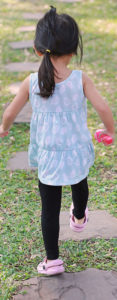
Within a print-rich environment, the child naturally works through the following 5 Stages:
1. Crying/body language –> 2. Speech –> 3. Scribbling/Drawing –> 4. Writing –> 5. Reading Books*
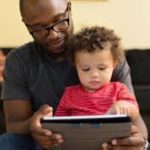 The first two stages unfold without our thinking much about our role in it. But to move beyond Speech, we need to be more aware of modeling what we’re doing.
The first two stages unfold without our thinking much about our role in it. But to move beyond Speech, we need to be more aware of modeling what we’re doing.
For to move past Speech, a child needs to see others writing. So at home this means seeing someone write notes, make grocery lists, etc.
 Before today’s digital age, children could easily see this happen. But now, with most of us using our devices to write, it means we need to make a point occasionally of showing them what we’re doing as we write emails and texts.
Before today’s digital age, children could easily see this happen. But now, with most of us using our devices to write, it means we need to make a point occasionally of showing them what we’re doing as we write emails and texts.

From seeing all this, the child realizes print is “talk written down.” And with access to paper and pencil, they will soon start scribbling what they mean to be “words” on their drawings.
So while nature provides the path and the child’s innate ability to absorb and practice on their own, we provide the print-rich environment and modeling essential to literacy.
But for a variety of reasons, some children have very little chance to see someone writing. This leaves them paused at Speech.
Children who have not gone beyond Speech are at a disadvantage, as they are likely to struggle, perhaps fail, with a traditional reading program in school.
traditional reading programs leave a gap
Formal reading instruction begins in 1st grade and is usually done with a traditional reading program. This may be a basal reading series (i.e., Dick and Jane, or later, Janet and Mark), which uses leveled books. Or it may be a phonics program, which features phonics worksheets, with practice in corresponding books.
So traditional approaches skip over the two stages in the child’s natural path — Scribbling/Drawing and Writing — and begin with books. And for a child not coming from a print-rich environment, this leaves a very large gap.
Here’s how the path looks for a child with little or no experience with print, when faced with a traditional reading program:
1. Crying/body language —> 2. Speech —> 3. Scribbling/Drawing —> 4. Writing —> 5. Reading Books
Such a child struggles to jump over that gap. And too many of them fail to make the leap.
The good news
The good news is that anyone interested enough in this topic to read this page has probably already been reading to their child and given them opportunities to see them writing. So they have already taken their child well into the Scribbling/Drawing stage.
This means their child already knows talk can be turned into print. And once a child discovers that, they want to do it themselves.
So now let’s take a look at a simple activity you can use to get your child even farther down the path.
Learn more about print while grocery shopping!
This activity will help your child move into writing on their own, by learning more about how to translate their “talk” into print. Here’s how to do it —
1. Gather materials:
-
-
-
- large index cards, cut in half, lengthwise. (Small recipe cards cut in half will do, too, or any other sturdy paper you can find.)
- one wide-tip marker for you to use, and some thin-tipped colored pens or colored pencils — for the child to draw.
- one metal ring — it can be a shower curtain ring or a sturdier ring that opens and closes easily
- a paper hole punch
-
-
2. Create a Key Word:
-
-
-
- Shortly before you actually leave for your next trip grocery shopping, tell the child what’s on your list, an
d have them choose the one item they favor the most. Encourage them to talk about it. For example, if it’s ice cream: how it tastes and what flavor
them to talk about it. For example, if it’s ice cream: how it tastes and what flavor - they like best, when you last bought them a cone, where to look for it in the grocery store, what t
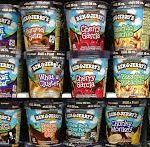 he carton looks like etc. Make sure they are actually envisioning it.
he carton looks like etc. Make sure they are actually envisioning it.

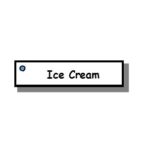 With the wide-tip pen, print the word (see below for charts for printing) saying the name of each letter as you go.
With the wide-tip pen, print the word (see below for charts for printing) saying the name of each letter as you go. - If their attention drifts, stop, and tell them you can’t go on until they watch.
- Have them trace over each letter with the index finger of their writing hand. You say the letter names as they go.
- Hold the word card away from them, so they see it at a 2 or 3 ft. distance, and say the word again.
Then ask them to say it, too.
- Shortly before you actually leave for your next trip grocery shopping, tell the child what’s on your list, an
-
-
3. Punch a hole on in the corner of the word card and help them place the word on the metal ring.
4. Let them carry the word with them as you go to the store. In the store, help them match the card to the words written by or on that item. See how many places they can find the word written close by. As you put the item on the conveyor belt at the check stand, let them place the word on top of it momentarily. (In short, do whatever you can think of to tie the word card to the item.)
5. The next time you do this (hopefully in the next 2 or 3 days), show them the word card and wait. Don’t say the word, wait to see if they remember it. If yes, then keep it on the word ring and add another word. If no, take it off and set it aside, without remarking on it — and give them a new word.
This time, try to be sure they are choosing something they really like, and perhaps talk about it a bit longer. Eventually they will get the idea and choose a word that has special meaning for them. Note: It is extremely important that only words they immediately recognize the next session stay on the ring. To see why, read more about Key Words here.
If you give only ONE word a day and keep only words on the word ring that they immediately recognize the following session, they will eventually have a collection of words they know and feel good about. (This is not yet “reading,” but a good step in that direction.)
alphabet formation guides
Your printing does not have to be perfect, but the style you use should be clear and consistent. Here’s a chart to use as to guide, in case you feel you need it.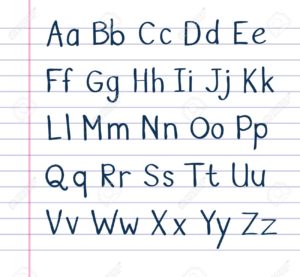
In most cases, lines go from top to bottom. Curves also begin at the top. Blue in the example below indicates where to begin. Again, the main thing is to decide how you want to print, then be consistent. 
Helping your child move farther along the path
If you enjoy this activity, you can easily expand on it. You can take a similar approach at home, having the child choose words that resonate with them — things they love, fear, want, etc. For how to support them as they grow, see Giving Key Words at Each Step.
For more about why this activity is so valuable, see A”Natural” Approach and the introductory paragraphs in Key Words and The Steps.
_________
*I use the term “Reading Books,” as children are reading familiar things all along. They are reading your expression, reading/recognizing labels to know which carton holds their favorite food, etc. They are also reading their own Key Words and other things they have written. So by Book Reading, I am referring to what we might call “cold reading” of books written by someone else. This is of course, the farthest out from the child and so the most difficult — and why no child should be asked to start there!